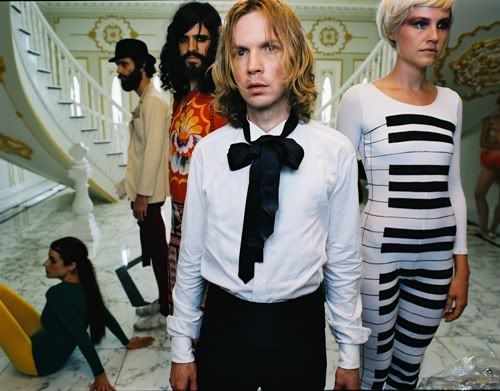Beck's Record Club: The Velvet Underground and Nico
RSL's Saturday Sound:
by Emma Dessau
by Emma Dessau
SONIC CHAMELEON - For those who haven’t heard, Beck Hansen, indie music king of California, has a new project. Each week, he and a band of fellow musicians and friends are uploading a cover song to the recently refurbished Beck.com, which they will have performed in one day without rehearsal. This past week, the crew recreated the classic 1967 The Velvet Underground and Nico album.
At the time of its release, The Velvet Underground and Nico reached a chart peak of No. 171 on The Billboard Top Album chart. The commercial failure of the record in the late 1960s is not shocking in retrospect. The Velvets were considered an extreme strain of the booming music scene in New York at the time. While Bob Dylan and Joan Baez sang protest songs in Cafe Wha?, the Velvets were uptown making music and art collaborations with Andy Warhol in his artsy drug den in Midtown Manhattan.
Alas, these days its almost sacrilege to not hail the Velvet Underground’s first record as ingenious, and rightly so: The album was simply ahead of its time. So it only makes sense that Beck and friends would do their best to rework it now, in a land where noise machines and electronic music have replaced scratchy violins for a weapon of choice. Here are some high points of the experiment:
“Black Angel Death Song,” in its original version, takes some time to love. The instruments are scratchy. The sound of a skipping record reels in the background. Primitive noise machines and cymbals shoot off in the distance. It is loud, it is noisy, it is powerful. But at least it is all of those things with purpose. In 1967, it pushed the boundaries of commercial music. In fact, it pushed so far the song went largely unnoticed for its genius lyrics. Lines like “And if Epiphany’s terror reduced you to shame/ have your head bobbed and weaved/ choose a side to be on,” simply got lost in the noise.
Oddly enough, if Beck’s Record Club version of “Black Angel Death Song” had been released in 1967, it may have been a bigger hit than the original. It sounds more Dylan-esque than like the Velvets. The noise machines have been replaced by acoustic guitar, played simple and pure. The best way to do a cover is to search for an innovative communication of it. Though this cover changes the overall feeling of the original recording, which is ominous and apocalyptic, it does so successfully. It sounds more like a Greenwich Village coffee house rant than a warning of rapture without offending the 1967 version’s message.
I have argued for the greatness of “All Tomorrow’s Parties” on many occasions, and I maintain that it is one of the strongest tracks on The Velvet Underground and Nico. Nico’s vocals, to quote a friend, “make your Adam’s apple feel like its about to jump out of your throat and run away.” Her voice is rich and horrifying with a hint of androgyny. Yet, something about her cooing, “What costume shall the poor girl wear to all tomorrow’s parties?” is soothing.
The Record Club cover features an electronic version of the original recording’s guitar riff, and the pace is kept true to form. Icelandic singer Thorunn Magnusdotti adds a more upbeat sound to the mix. This is both enjoyable and infuriating, because only Nico can communicate volumes with her droning sound. That repetitive pounding drum of the original mixed with her haunting singing is so vivid, I’m not sure it’s even fair to try to cover the song. Still, it is an admirable attempt.
There is something very appealing about the Record Club’s version of “Run, Run, Run.” However, it is not the singing that makes this cover so successful. That is not to say there is anything wrong with the vocals. To the contrary, the vocal monotony works extremely well in contrast with the sweet, poppy background. Anything more emotional would ruin it. The cover’s upbeat pace, full of electronic noise machine goodness, sounds almost like it should be played right on top of the VU version. It compliments the original’s patterns flawlessly, without overpowering it.
I was surprised to find that my favorite cover was born of one of my least favorite tracks on the original album. Contrasting the pleasant monotony in the vocals of “Run, Run, Run,” on “Venus in Furs,” Beck is fully emotional. He sings like a true rock star, displaying a very Lou Reed attachment to each word. The well known chorus, “I am tired/ I am weary/ I could sleep a thousand years” is exciting. It makes you want to stomp your boots of shiny, shiny, leather quite violently.
The beauty here is that the Record Club version pays homage to the original “Venus in Furs,” which Beck proclaimed on his site, “Possibly one of the first, if not the first goth song ever?,” without sounding like a carbon copy. It is very similar, but instead of sticking to thoroughly gothic undertones, it explores the light. The subtle upbeat step Reed’s voice takes at the start of each chorus in the original is elaborated upon here. The music takes us from hell and back, and it does not keep us under a dark spell the way the 1967 original does.




Comments
ciao
v.